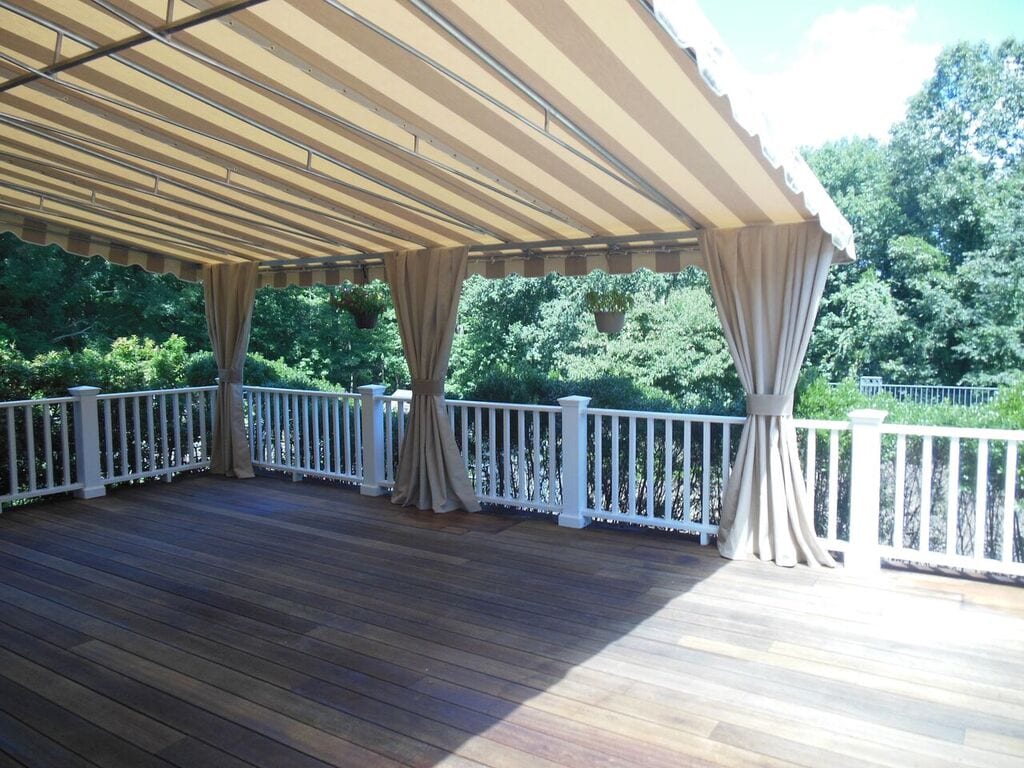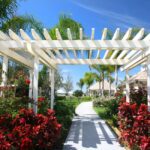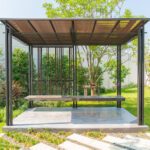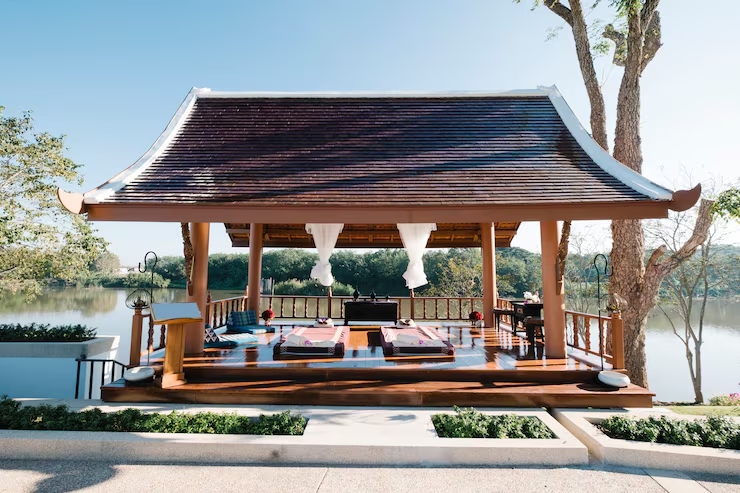Table of Contents
Key Takeaways
5 Clear Signs It’s Time to Replace Your Awning
1. Visible Wear and Tear
2. Mold, Mildew, or Stains
3. Structural Damage
4. Sagging or Loose Fabric
5. Ineffective UV Protection
Frequently Asked Questions
How do I maintain and clean an awning?
What materials are used to make awnings?
How do awnings impact energy efficiency?
Can I install an awning myself?
How long do awnings typically last?
Upgrade Your Awning with Connecticut’s Trusted Experts — Durkin’s!
Key Takeaways
|
Awnings are crucial in providing shade, protection, and comfort to your outdoor space, but like anyany exterior feature, they don’t last forever. Over time, wear and tear can compromise its effectiveness, leaving your patio or deck exposed to the elements. If you’ve started to notice any of these signs, it may be time to consider an awning replacement.
5 Clear Signs It’s Time to Replace Your Awning
1. Visible Wear and Tear
Your awning is exposed to the elements every day, and over time, it will begin to show signs of aging and damage. One of the most obvious signs that your awning is due for a replacement is visible wear and tear.
Faded or Discolored Fabric
The fabric of your awning plays a vital role in providing shade and protection from the sun. However, constant exposure to UV rays, rain, and wind can cause the fabric to fade or become discolored. This not only affects the appearance of your outdoor space but also signals that your awning may no longer offer the same level of protection it once did.
- Sun Exposure: Prolonged UV radiation can bleach the color of the fabric.
- Rain and Moisture: Constant exposure to rain can lead to water stains or mildew, which discolors the fabric.
- Age: Over time, even high-quality awnings lose their vibrant color and start to look worn.
Tears, Holes, or Fraying Edges
While faded fabric can diminish the look of your awning, physical damage like tears, holes, or fraying edges is a more serious issue. Not only does it look unsightly, but it can also make your awning less effective at providing shade and protection. Damaged fabric may worsen over time, leading to more costly repairs or complete failure of the awning.
- Wind Damage: Strong winds can cause the fabric to stretch or tear, especially if the awning is left open during storms.
- Debris: Falling branches, leaves, or other debris can puncture the fabric.
- Fabric Wear: Continuous retraction and extension of the awning can wear down the edges, causing fraying or splitting.
2. Mold, Mildew, or Stains
Your awning is constantly exposed to the elements, making it vulnerable to mold, mildew, and persistent stains. While occasional cleaning can help, there are some issues that can’t be fixed and signal that it’s time for a replacement.
Growth of Mold or Mildew on the Awning Fabric
One of the most common problems awnings face is mold and mildew growth, especially if they are frequently exposed to moisture. These fungi thrive in damp environments, making your awning the perfect host if it’s left wet for long periods. Mold and mildew not only ruin the appearance of your awning but also pose health risks and contribute to unpleasant odors.
- Dark or greenish spots on the fabric
- A musty smell coming from the awning
- Visible spores or patches growing on the underside or edges
Once mold or mildew sets in, it can be difficult to remove completely. Even with thorough cleaning, some stains may remain, and the awning fabric might weaken over time.
Persistent Stains That Can’t Be Cleaned
Another issue that signals it’s time to replace your awning is the presence of stubborn stains. Over time, exposure to bird droppings, tree sap, and other outdoor elements can leave unsightly marks on your awning that don’t come off, no matter how hard you scrub.
- Bird droppings
- Tree sap and pollen
- Rust from nearby metal surfaces
- Pollution and environmental debris
Persistent stains can make your awning look old and dirty, diminishing the overall appeal of your outdoor space. If cleaning products no longer work and the stains have set in deeply, replacing the awning might be your best option for restoring the aesthetic of your home or business.
When to Consider Replacing Your Awning
While minor mold, mildew, or stains can sometimes be treated, there are clear signs that it’s time for a new awning:
- Fabric Deterioration: If the awning fabric feels thin or brittle, replacement is necessary.
- Permanent Discoloration: Stains that have deeply set into the fabric and can’t be removed.
- Odor Issues: Musty smells that persist even after cleaning are a sign of deep mold or mildew infiltration.
3. Structural Damage
One of the most obvious signs that your awning is begging for a replacement is structural damage. The awning’s frame is the backbone that supports the fabric, ensuring it provides the necessary shade and protection. Over time, exposure to the elements can take a toll on this structure, leading to bent or broken parts and even rust or corrosion on metal components.
Bent or Broken Frame
The frame of an awning is designed to withstand various weather conditions, but over time, heavy wind, rain, or snow can cause it to bend or break. If you notice that your awning’s frame is no longer straight or has visible damage, it’s a clear indication that it’s no longer functioning as it should.
- Uneven Tension on the Fabric: The awning fabric may appear loose or slack on one side, indicating that the frame is no longer providing balanced support. This uneven tension can cause additional stress on the fabric, leading to premature wear, tears, or sagging over time, further compromising the awning’s overall functionality.
- Difficulty in Extending or Retracting the Awning: A bent frame can cause the awning to jam or become difficult to operate smoothly, leading to frustrating manual adjustments or even mechanical failure. Over time, this strain on the awning’s mechanisms can cause permanent damage, making it impossible to extend or retract the awning properly without costly repairs.
- Increased Risk of Collapse During Inclement Weather: A compromised frame is more likely to give way under pressure from wind, rain, or snow, putting the entire awning structure at risk of collapse. This not only jeopardizes the safety of your outdoor space but also increases the likelihood of damage to your home or property during severe weather conditions.
Rust or Corrosion on Metal Parts
Metal components in your awning’s frame are prone to rust and corrosion, especially if they’re exposed to moisture over extended periods. Rust weakens the integrity of the metal, making it more susceptible to breakage or malfunction. It’s important to regularly check for any signs of rust or corrosion on your awning.
Here are some of the most common signs that rust or corrosion has started to affect your awning’s frame and components.
- Visible Red or Brown Patches on the Metal Surface: Visible red or brown patches on your awning’s metal parts are an early sign of rust formation caused by prolonged moisture exposure. These discolorations indicate oxidation and, if left unchecked, can spread, weakening the metal. Rust compromises the frame’s strength, increasing the risk of failure during windy or stormy conditions, making it a serious structural concern.
- Flaking or Chipping of Metal: As rust progresses beyond discoloration, it starts to erode the metal, leading to peeling, flaking, or chipping. This advanced rust damage severely weakens the metal, making it unable to properly support the awning. Key signs include small metal pieces breaking off, rough or uneven surfaces, and visible holes. When rust reaches this stage, the frame’s strength is significantly reduced, increasing the risk of failure under wind, snow, or fabric weight, and creating potential safety hazards.
- Creaking or Grinding Noise When Operating the Awning: Rust doesn’t just affect the appearance of your awning; it also impacts its functionality, especially in moving parts like joints, hinges, and retractable mechanisms. Rust buildup in these areas creates friction, making it harder to operate the awning smoothly. Common signs include creaking or grinding noises, stiffness when extending or retracting, and jerky movements. This added friction causes wear and tear on key components, leading to potential breakdowns or costly repairs. If left unaddressed, rust can cause the awning to get stuck or even collapse.
4. Sagging or Loose Fabric
One of the most noticeable signs that your awning is begging for a replacement is sagging or loose fabric. When the fabric of your awning begins to droop, either in the middle or around the edges, it compromises both the aesthetic and functionality of the awning.
Common Causes of Fabric Sagging
Over time, the fabric of your awning can stretch, weaken, or become damaged due to various factors. Here are some common causes:
- Weather Exposure: Constant exposure to rain, wind, and sun can cause the fabric to lose its shape and elasticity.
- Aging: As the awning ages, the material naturally begins to deteriorate, causing it to sag.
- Improper Installation: If the awning was not installed correctly, the fabric may not be tightly secured, leading to sagging.
Impact of Sagging Awning Fabric
A sagging or loose awning isn’t just an eyesore—it also affects the functionality of the awning in several ways:
- Reduced Shade: Sagging fabric provides less effective coverage, allowing more sunlight and heat to pass through.
- Water Pooling: When the fabric sags, rainwater can collect in the dips, causing further strain on the fabric and frame.
- Increased Wear and Tear: The added tension from sagging leads to faster deterioration of both the fabric and the structure of the awning.
Loose or Misaligned Awning Arms
In addition to fabric issues, the arms of your awning may become loose or misaligned over time. This can be due to:
- Frequent Use: Constant extension and retraction can loosen the mechanical parts.
- Storm Damage: High winds or heavy rain can knock the awning arms out of alignment, making the fabric appear loose.
- General Wear: Over time, regular wear and tear can cause the arms to weaken or become misaligned.
5. Ineffective UV Protection
One of the primary purposes of an awning is to provide shade and protect you from the harsh effects of the sun. Over time, however, your awning may begin to lose its ability to block harmful UV rays effectively. When this happens, it could be a clear indication that your awning is begging for a replacement.
Increased Sunlight and Heat Penetration
As your awning ages, you may notice more sunlight filtering through the fabric. This increased exposure not only makes your outdoor space uncomfortable but also defeats the awning’s purpose. One of the main benefits of an awning is its ability to keep your patio or deck cool. When heat and sunlight start to penetrate more easily, it’s a strong indication that the material has degraded.
- Brighter or Warmer Areas Under the Awning: When specific spots beneath your awning feel noticeably warmer or brighter, this suggests that the fabric is wearing thin. The protective layer that once blocked harmful UV rays and heat is no longer effective, allowing more sunlight to penetrate through.
- Sunlight Passing Through Worn-Out Patches: If you can see sunlight coming through small, thin areas or holes in the awning fabric, it’s a clear sign that the material has degraded. These worn-out patches mean the awning is losing its ability to provide the shade and protection it once did.
- Inability to Maintain a Cool Temperature Outdoors: One of the main purposes of an awning is to create a comfortable, shaded space. If you’re finding it difficult to keep your outdoor area cool even with the awning in place, it suggests that the fabric has lost its ability to block heat and UV rays effectively. This not only reduces comfort but may also expose you and your furniture to harmful sun exposure.
Why It Matters
When your awning loses its UV-blocking ability, it can lead to multiple problems:
- Health Risks: Prolonged exposure to UV rays can increase the risk of skin cancer and other sun-related health issues.
- Damage to Furniture and Flooring: UV rays can cause your outdoor furniture, rugs, and decking to fade and deteriorate more quickly.
- Reduced Comfort: A well-functioning awning keeps your outdoor space cool and enjoyable. Without proper UV protection, your outdoor area may become uncomfortably warm and less inviting.
Post that you may also like: How to Choose the Perfect Commercial Awning
Frequently Asked Questions
How do I maintain and clean an awning?
Regular maintenance of an awning involves checking for any damage, like tears or loose hardware, and cleaning it to prevent the buildup of dirt, mold, or mildew. Fabric awnings can be cleaned using a mild detergent and water, while metal awnings may require a rust-resistant treatment. Retractable awnings should be retracted during severe weather to prevent damage. Proper maintenance can extend the lifespan of an awning and keep it looking new.
What materials are used to make awnings?
Awnings are commonly made from materials such as acrylic fabric, vinyl, canvas, aluminum, or polycarbonate. Acrylic fabrics are popular because they are UV-resistant and durable, while vinyl offers weatherproof properties and is easy to clean. Metal awnings, particularly aluminum, are long-lasting and sturdy but may require regular maintenance to prevent corrosion. Polycarbonate awnings are lightweight and often used for their transparency and impact resistance.
How do awnings impact energy efficiency?
Awnings can significantly reduce the amount of heat that enters a building by blocking direct sunlight, which helps lower indoor temperatures. This heat reduction can lessen the need for air conditioning, leading to energy savings. According to some studies, awnings can reduce cooling costs by up to 25%. Additionally, they provide shade for outdoor spaces, making these areas more comfortable without the need for extra cooling devices.
Can I install an awning myself?
While it is possible to install an awning yourself, it is generally recommended to have a professional handle the installation, especially for larger or motorized retractable awnings. Improper installation can lead to structural issues, reduced durability, or poor performance. A professional will ensure the awning is securely attached and aligned correctly, which is essential for long-term functionality. Additionally, professional installers often provide warranties for their work.
How long do awnings typically last?
The lifespan of an awning depends on the material, quality, and how well it is maintained. Fabric awnings usually last around 5 to 15 years, with higher-end materials like acrylic lasting longer. Metal awnings, such as aluminum, can last up to 20 years or more with proper care. Regular cleaning, inspections, and retracting during bad weather can extend the lifespan of both fabric and metal awnings.
Post You May Also Like: Do’s and Don’ts of Awning Care

Upgrade Your Awning with Connecticut’s Trusted Experts — Durkin’s!
For top-quality awnings that enhance your outdoor space and protect you from the sun, trust Durkin’s in Connecticut. Our experienced team provides durable, UV-resistant awnings that are custom-made to suit your style and needs. Whether you’re looking to replace an old, worn-out awning or install a brand-new one, Durkin’s has been serving Connecticut for decades, delivering excellent craftsmanship and reliable products.
Get in touch today to enjoy the comfort and protection you deserve in your Connecticut home. Contact us now!













